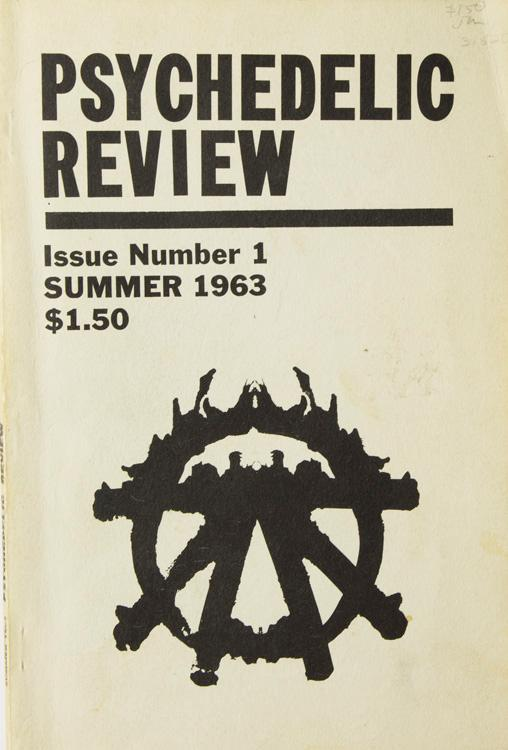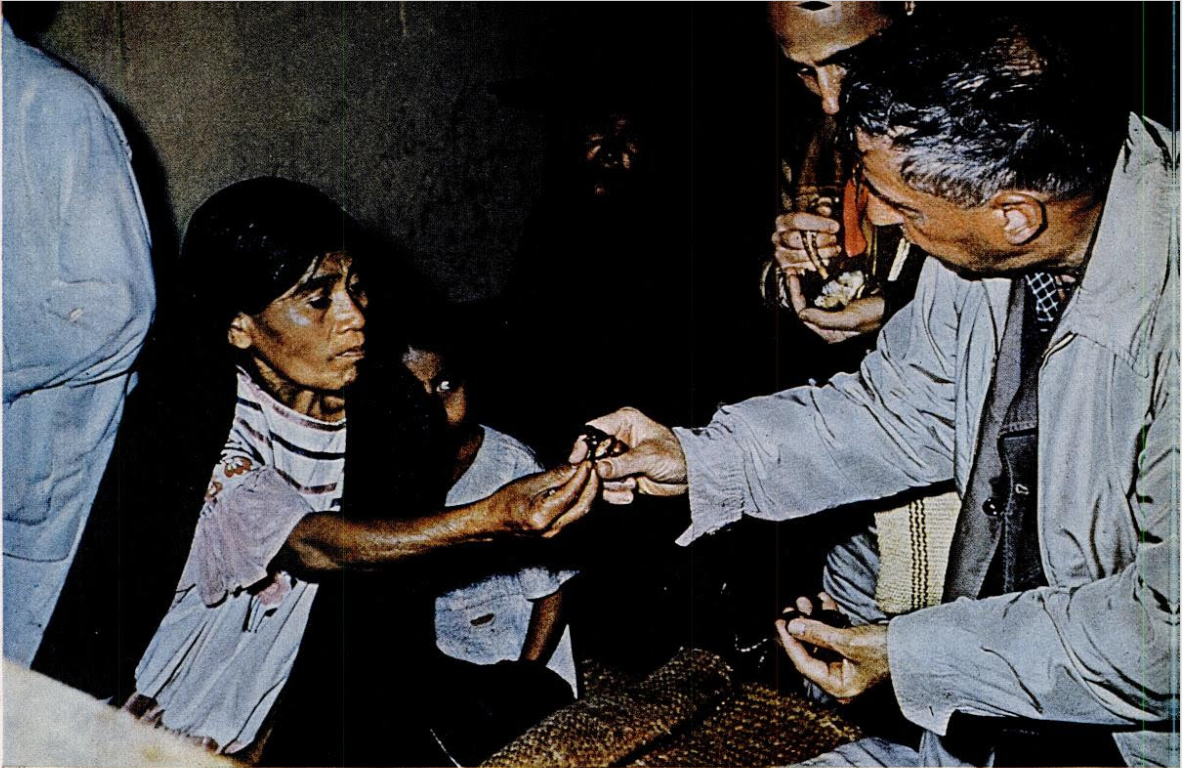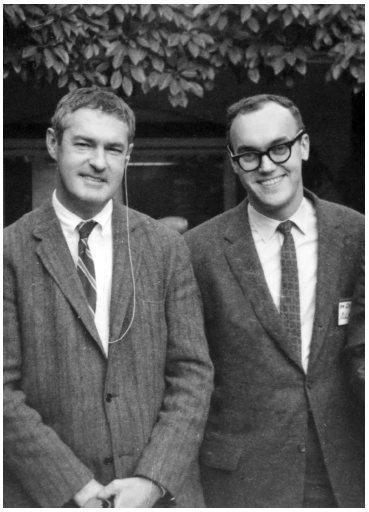
by Erica Frank
The science fiction haul at Playboy has gotten smaller, although this half-year batch is fairly good.
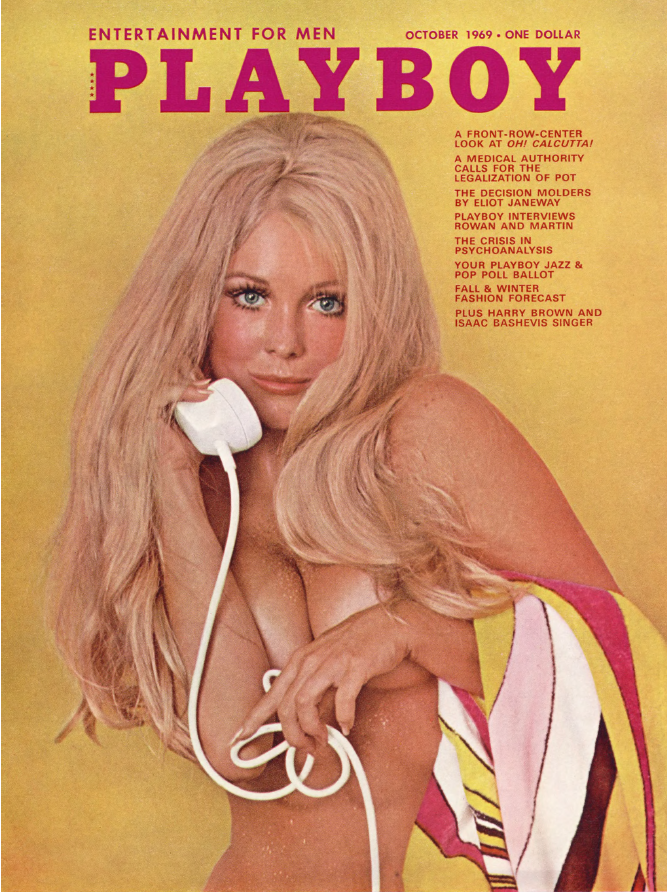
Playboy's October 1969 cover–the trick with the cord is cute.
Slaves or Masters? by David Rorvik (July)
This is an article about the future of robotics. The word robot comes from the 1921 science-fiction play R.U.R. (Rossum´s Universal Robots) by Karel Čapek; it's derived from a word that means "worker."
This article gives an overview of the history of robots (dreams of robot workers go back to the Iliad and the "mechanical golden girls" serving Hephaestus), discusses what separates them from mere machines — and goes on to assign them human emotions.

Machinery does not have "nervous breakdowns," and nervous breakdowns are not fixed by circuit changes.
Robot emotions aside, they are a welcome addition to the labor force, as they can be assigned tasks that are too dangerous or difficult for humans. They can lift heavier objects and be designed to reach into places that human hands cannot. So despite the worries of some fiction, they’re not “stealing human jobs” – they’re reducing human risk and allowing precision that humans can’t get.
However, the author seems to think that, in 15 years or so, we'll have a Jetson's-style Rosie-the-Robot in every household. Three stars; the writing is good and the details are solid, but the conclusions don’t match the data available. Four stars, if you really like robots.
A Breath of Lucifer by R. K. Narayan (July)
Sam the nurse is helping our nameless protagonist recover from eye surgery by being his 24/7 attendant and eyes. He gets paid 8 rupees a day… a little more than one dollar, with which he supports a wife, 8 children, two sisters, and a niece. Sam talks of his past in wartime, on campaigns, but does not mention which war, which locations. Sam integrates himself in family visits and seems oddly jealous of the other nurses, and keeps returning to his story of portraying Lucifer in a play.
Like many Playboy stories, this is pleasant to read and goes nowhere. It is unclear if there are any fantastic elements in this other than Sam's exotic stories. Three stars.
Can You Feel Anything When I Do This? by Robert Sheckley (August)
A middle-class housewife gets a surprise delivery from Stern’s Department Store. She is upset that someone bought her a (boring) vacuum cleaner when she already has one. She plugs it in and it announces its identity and abilities.
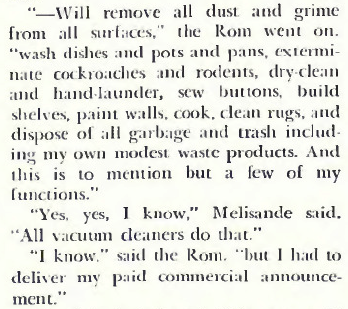
In the future, vacuum cleaners will wash dishes, sew buttons, iron your clothes, and take out the trash.
After removing a stain on her clothing, the vacuum notices Melisande was tense, and gives her a massage with several attachments directed at different muscle groups. She is grateful for the assistance, but concerned about how it feels… “Should it feel so good?” The robot tells her it’s a side effect of the treatment. “Pleasure is sometimes unavoidable in the pursuit of health.” It proceeds to… address her health… at great length.
She demands to know who sent him, and he says he sent himself, that he saw her shopping and fell in love. "And now we have found each other, despite inconceivabilities…. We must make plans."
The ending has a nice twist — Melisande is no man's toy — and I think only the not-quite-declared robot-enhanced orgasm earlier allowed this story to work its way into Playboy, because it doesn’t normally carry much in the way of feminist themes. Four stars.
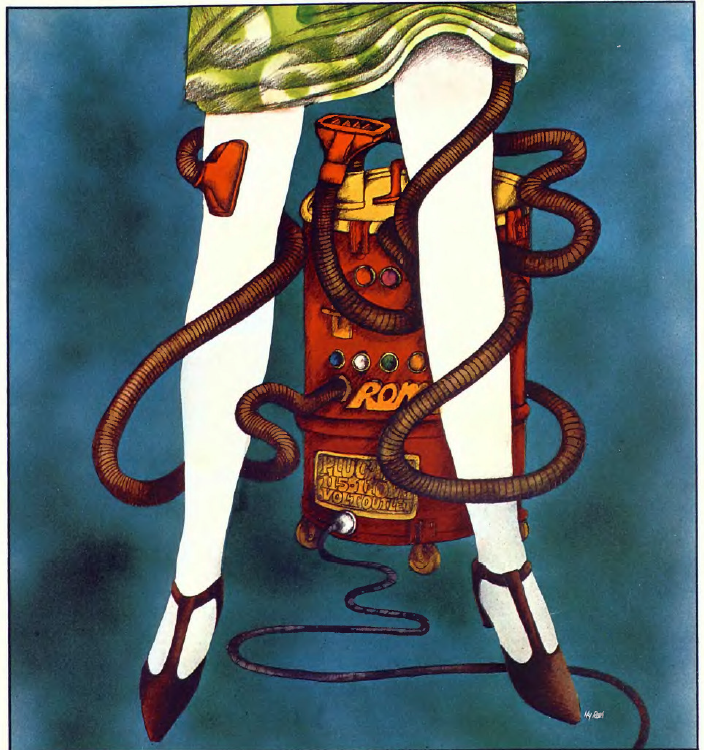
Illustration by Hy Roth
The Dannold Cheque by Ken W. Purdy (September)
A dealer of antiquities combines “autograph, artifact, photograph” to sell for very high prices. (One piece: a holograph of a 1938 letter by Winston Churchill mentioning a drought; a small clipping of grass from the area, and a photo of the man himself.) He discusses a project with Mr. Dannold: Dannold once chanced to thwart an assassination attempt against the Prime Minister, and has a voided £250,000 cheque to commemorate the event.
He was going to receive the hefty award, but before it got to him, he admitted that he didn’t vote for the prime minister and considered his election an “unmitigated disaster.” The cheque was cancelled before he could reach a bank; it was a worthless novelty he carried for decades before he found the antiques dealer. He sold it for 50,000 francs. (About $10,000 – quite a lot of money, enough to buy several new cars, but nothing compared to the almost $600,000 value of the original!)
This is a fascinating example of a science fiction setting with no science fiction themes at all. A sprinkling of technological terminology is scattered throughout the story; a mention of a painter from 2068… but the story is a bog-standard “sold an interesting curio to a pawn shop” tale. And it was rather difficult to put the timeline of events together, possibly because I kept waiting for something science-fictional other than “this is set in the future.” Two stars.
Alice & Ray & Yesterday's Flowers by Saul Braun (October)
This is the story about the people behind the song Alices’s Restaurant, which shot Arlo Guthrie into fame. Apparently the song takes some artistic license with the story… there weren’t any handcuffs. And the second half of the song – Arlo vs the Draft Board – was pure fiction when the song was written, and did not become fact later, even if parts of it were used as inspiration. The movie takes even more license with the story.
The article here is about life with Alice & Ray in their church-converted-to-a-residence, a hippie haven that sounds very colorful and festive:
The radical activists are the same old noise, but the others are new, and, friends, they are turning. Only from within is it possible even to find them— and to know that are witnessing here is a major turning. While our astronauts fly to the moon, these other pioneers fly to a place of altered perceptions and altered relations, of altered being, of extreme presentness, virtually without past or future.
It’s a nice blend of exposition and contemplation, taking the personal experiences of a handful of people and using it as a showcase of a broader movement and shift in cultural awareness. Three stars.
Pot: A Rational Approach by Joel Fort, MD (October)
On May 19, 1969, the US Supreme Court ruled unanimously that the 1937 Marijuana Tax Act was unconstitutional. Notably, it’s unconstitutional to require people to incriminate themselves, and the MTA did exactly that.
The article makes a strong argument that marijuana should be legalized: that its health benefits are certainly no worse than alcohol, that the penalties for it are often excessive (rape can get a person five years in prison; selling a matchbox of weed can be 50 years), that there is no solid evidence that its use leads to harder drugs, and so on. It’s extensive and well-written, and it will convince nobody but its carefully selected audience of wealthy men who like to think themselves intellectuals. Three stars.
1970 Jazz and Pop Poll (October)
This is provided just for fun; we are long past the deadline for the actual poll. Please avail yourself of a copy of this ballot, complete with a stunning cover page starring Janis Joplin, and discuss your choices with your friends.

Nine Lives by Ursula K. Le Guin (November)
A pair of interstellar miners, after searching and working alone for years, have found their target planet and their support crew arrives – a tenclone of five males, five females, all with the same beautiful bronze body and attractive face and genius mind. Ten identical twins whose entire lives are focused only on each other.
Until a mining accident kills nine of them, and the one who’s left has to try to figure out how to be a person without the only family – the only sense of self – he’s ever known. A fascinating and haunting story that explores the nature of identity and companionship. Five stars.
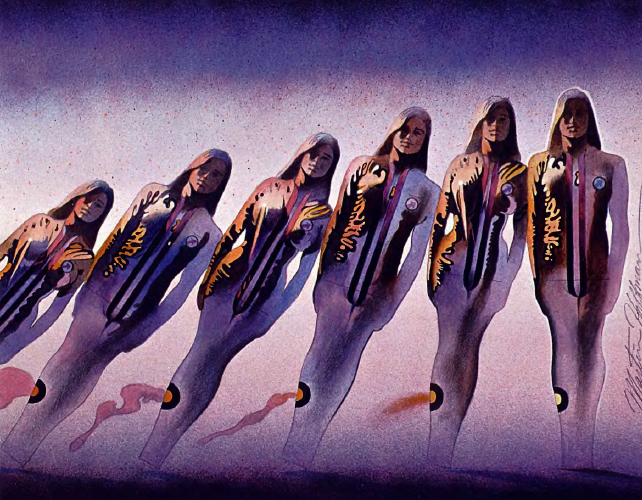
They’re all John Chow, but they need a way to identify each other. The men were Aleph, Kaph, Yod, Gimel and Samekh; the women Sadhe, Daleth, Zayin, Beth and Resh.
Cordle to Onion to Carrot by Robert Sheckley (December)
Howard Cordle was a milquetoast sort of man who got pushed around a lot, until he met the god Thoth-Hermes (definitely a god, not a hallucination, not a stoned hitchhiker) who told him that “the Stew” (metaphor for all reality) needs both “carrots” (aggressive bullies) and “onions” (passive victims like himself). After a moment of enlightenment, he decides to try his hand at carrothood.
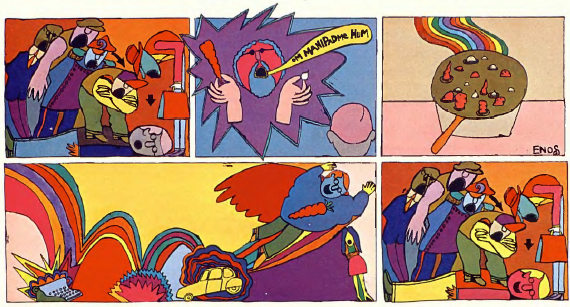
Cordle is polite, friendly, and accommodating – until he faces discrimination because he doesn’t seem high-class enough for whatever venue he is visiting, at which point, Cordle invokes his inner carrot and becomes what is colloquially known as an “obnoxious asshole.” He does wind up with better service this way, but almost drives away the woman he loves, who thought he was not like that. When they are married, he takes his vacations alone.
There is almost no science fiction here, although Sheckley is an accomplished SF writer and the tone and style come through. The story is enjoyable but has no real resolution, with a potential message of “being an asshole can get you what you want; the cost is… being an asshole.” Three stars.
Episode & Postscript by Timothy Leary (December)
This is a memoir, of sorts, recounting some of the events following his & his family’s 1965 arrest for less than an ounce of marijuana. (The ultimate result of this case was the Supreme Court ruling that nullified the MTA.) He begins not by focusing on the legal hassles involved, but on the concept of pleasure vs reward.
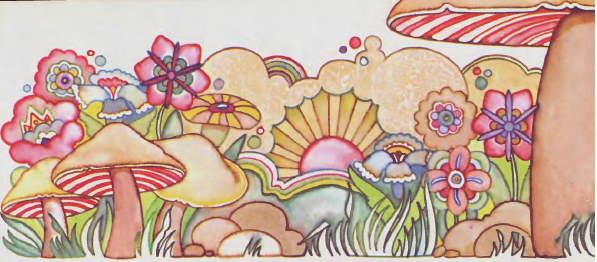
The first several pages are decorated with flowers and mushrooms.
He does not denounce the sense of accomplishment that goes with rewards, but wants people to be more in tune with the natural sense of pleasure of just being themselves, not requiring external stimuli and game-systems to feel at peace.
This is an engaging read, although he shows the racism expected of a white man with an elite education: He praises black people for being more in tune with “natural fleshly pleasures.”
His understanding of the laws around psychedelics is interesting, and his accounting of the events make it clear that he believes everyone is playing out their roles, which he intends to disrupt.
In between his philosophical meanderings, he manages to tell the story of his arrest, and how he made the decision to challenge the constitutionality of the marijuana laws rather than accept a plea bargain and get off with a few years of probation. They had a system, you see, and Leary declined to go along with it. He got a 30-year sentence that was put on hold while he challenged the law itself.
Four stars if you have an interest in drug laws or hippie philosophy; three stars otherwise.
I think I'm done reviewing Playboy. They're very expensive for so little science fiction, and I'm not fond of most of the interviews and the humor. I am glad I read this set, though; the Le Guin story was wonderful, and both the Sheckley stories were fun.

![[December 4, 1969] "Weed" and Weirdness (July–December 1969 <i>Playboy</i>)](https://galacticjourney.org/wp-content/uploads/2024/12/6912_PBCover_Oct69-667x372.png)


![[October 14, 1963] Take a little trip… (Timothy Leary's <i>Psychedelic Review</i>)](https://galacticjourney.org/wp-content/uploads/2018/10/631014psychrev1-1cvr-508x372.png)

